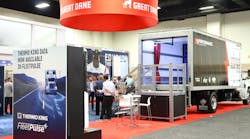IF a single company accounted for almost 20% of your sales, chances are that company would rank at the top of your customer list, and you would want to take good care of that customer.
While there is a world of difference between a customer-supplier relationship and the import and export transactions conducted between sovereign nations, that analogy is a good way of looking at the way the United States and Canada relate to one another. According to the latest figures compiled by the United States Census Bureau, Canadians bought 18.5% of American exports in November—more than any other country.
The relationship is just about as strong going the other direction, with the U S the top Canadian trading partner.
Combined, the United States and Canada buy $1.6 billion worth of stuff from one another every day and transport it across our shared border. That’s more money than the Powerball jackpot—and more reliable because it pays off every day.
Historically, Canada is our best customer and (with the exception of China recently) our top supplier, according to the United States International Trade Commission.
All of this should be of interest to those who build commercial trucks and trailers. Transportation-related equipment is the second-largest category of goods shipped between the two nations—exceeded only by the energy industry that fuels those products.
Doing business in both countries certainly is at the forefront of this month’s cover story (see Page 18). With its new van body plant in suburban Ontario, Multivans has big plans for strengthening its presence in the U S truck body market.
“We ship product throughout Canada and are reaching into New England, New York, Ohio, Pennsylvania, Indiana, Michigan and even Wisconsin,” says Fred Seymour, president. “We see real opportunity in the US, especially those areas closest to us. We estimate the Canadian market for our products at $120 million in annual sales. We believe the US market on the other side of the Great Lakes—but within shipping distance from our plant—is $180 million.”
The continued fall of the Canadian dollar will make Canadian manufacturers more competitive as they seek business from U S customers. Exchange rates can be volatile, and it would be foolish to base long-term commitments on short-term conditions. But favorable exchange rates a few decades ago helped some Canadian dump body manufacturers establish a presence in New England and elsewhere in the Northeast. Some have been able to remain in the market, including times in which the Canadian dollar was priced higher.
As this is being written, the Canadian dollar has dropped to its lowest level in 13 years—essentially providing a 30% discount to U S customers. But the currency fluctuations can cut both ways. Many Canadian manufacturers rely heavily on U S suppliers, and those vendors expect to be paid in U S dollars. Today Canadians will need to spend $1.44 of their currency for every greenback they owe.
Exchange rates are but one issue involved in moving commercial trucks and trailers between the two countries. Our introductory story on the recent Canadian Transportation Equipment Association’s annual Manufacturers Conference (see Page 26) touches on several others:
• Safety regulations. There are still differences, but with truck and trailer manufacturers relying on each other for components and materials, the countries have an incentive to make regulations as similar as possible. Underride guard regulations are a good example of how the two countries almost (but not quite) adopt the same motor vehicle safety standards. After NHTSA implemented FMVSS 223 and FMVSS 224, Transport Canada followed with CMVSS 223 and 224—similar, but not identical. In December, NHTSA announced it essentially is adopting (but not quite) the Canadian standards. And as CTEA points out on Page 28, Transport Canada will consider adopting differences in NHTSA’s final rule (particularly the expected changes in the location of the underride guard’s vertical members).
• Environmental regulations. Canadian regulators are watching the NHTSA/EPA’s greenhouse gas regulations unfold and are expected to implement similar requirements for Canadian trucks and trailers.
• Battling border bottlenecks. Given the volume of trucks, trailers, and equipment being imported and exported, customs can be a pinch point for getting goods to their destination. Governments, trade associations, and companies on both sides of the border are working together to make international commerce flow more smoothly. But that shouldn’t be surprising. Wouldn’t you do that for your best customer? ♦










